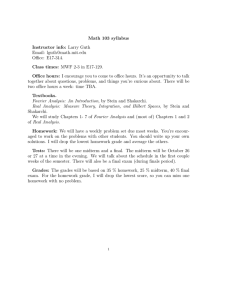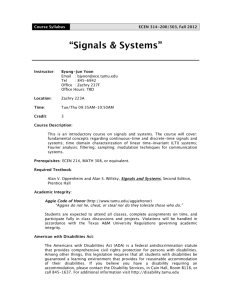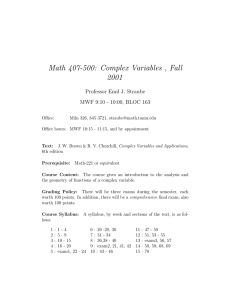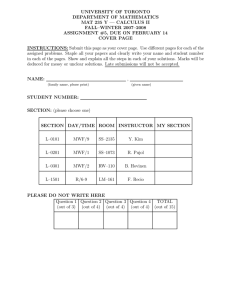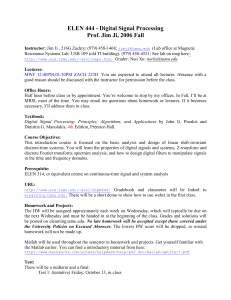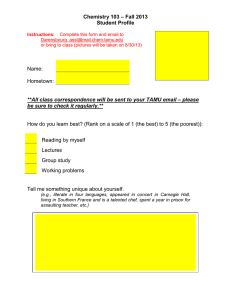Syllabus - Henry D. Pfister
advertisement
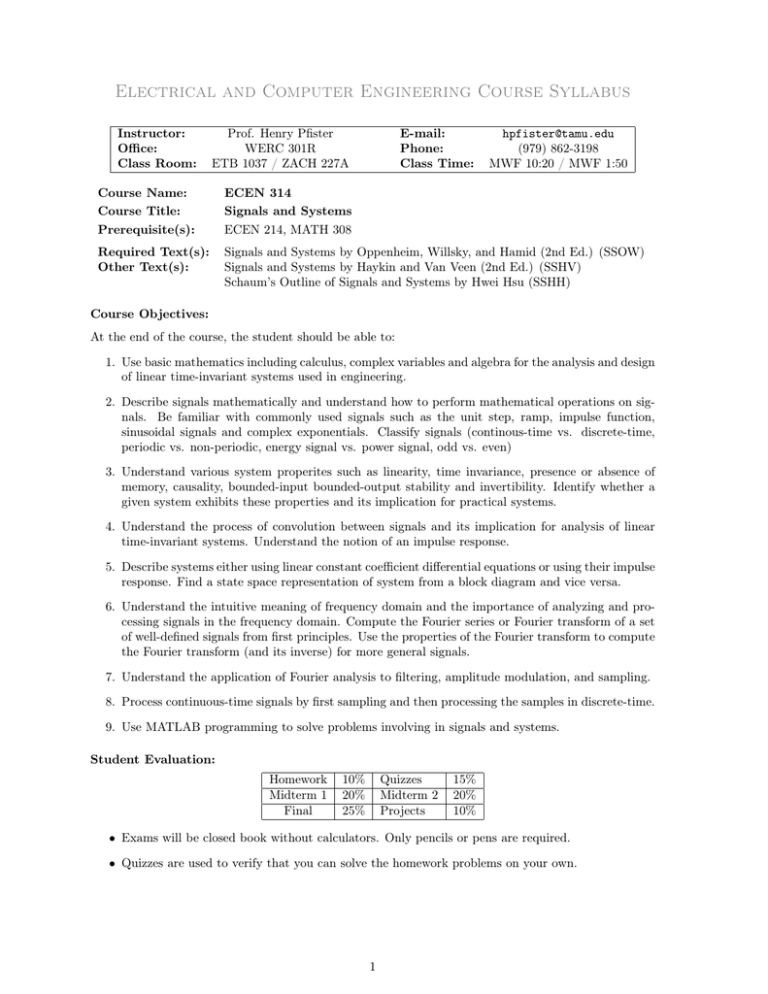
Electrical and Computer Engineering Course Syllabus Instructor: Office: Class Room: Prof. Henry Pfister WERC 301R ETB 1037 / ZACH 227A E-mail: Phone: Class Time: Course Name: Course Title: Prerequisite(s): ECEN 314 Signals and Systems ECEN 214, MATH 308 Required Text(s): Other Text(s): Signals and Systems by Oppenheim, Willsky, and Hamid (2nd Ed.) (SSOW) Signals and Systems by Haykin and Van Veen (2nd Ed.) (SSHV) Schaum’s Outline of Signals and Systems by Hwei Hsu (SSHH) hpfister@tamu.edu (979) 862-3198 MWF 10:20 / MWF 1:50 Course Objectives: At the end of the course, the student should be able to: 1. Use basic mathematics including calculus, complex variables and algebra for the analysis and design of linear time-invariant systems used in engineering. 2. Describe signals mathematically and understand how to perform mathematical operations on signals. Be familiar with commonly used signals such as the unit step, ramp, impulse function, sinusoidal signals and complex exponentials. Classify signals (continous-time vs. discrete-time, periodic vs. non-periodic, energy signal vs. power signal, odd vs. even) 3. Understand various system properites such as linearity, time invariance, presence or absence of memory, causality, bounded-input bounded-output stability and invertibility. Identify whether a given system exhibits these properties and its implication for practical systems. 4. Understand the process of convolution between signals and its implication for analysis of linear time-invariant systems. Understand the notion of an impulse response. 5. Describe systems either using linear constant coefficient differential equations or using their impulse response. Find a state space representation of system from a block diagram and vice versa. 6. Understand the intuitive meaning of frequency domain and the importance of analyzing and processing signals in the frequency domain. Compute the Fourier series or Fourier transform of a set of well-defined signals from first principles. Use the properties of the Fourier transform to compute the Fourier transform (and its inverse) for more general signals. 7. Understand the application of Fourier analysis to filtering, amplitude modulation, and sampling. 8. Process continuous-time signals by first sampling and then processing the samples in discrete-time. 9. Use MATLAB programming to solve problems involving in signals and systems. Student Evaluation: Homework Midterm 1 Final 10% 20% 25% Quizzes Midterm 2 Projects 15% 20% 10% • Exams will be closed book without calculators. Only pencils or pens are required. • Quizzes are used to verify that you can solve the homework problems on your own. 1 Rules and Guidelines: The class shall follow all established policies of TAMU. This includes the Aggie Honor Code and the Americans with Disabilities Act (ADA). The honor code is “An Aggie does not lie, cheat, or steal or tolerate those who do.” and more information is available from http://www.tamu.edu/aggiehonor. The ADA is a federal anti-discrimation statute that provides comprehensive civil rights prtotection for persons with disabilities and more information is available from http://disability.tamu.edu. Links to these and other policies can be found at http://www.ece.tamu.edu/~hpfister/courses.html. Course Topics: Unit 1 2 3 4 5 6 7 8 9 10 Schedule: Week 1 2 3 4 5 6 7 8 X 9 10 11 12 13 14 15 Date 1/14 1/21 1/28 2/4 2/11 2/18 2/25 3/4 3/11 3/18 3/25 4/1 4/8 4/15 4/22 4/29 Topics Introduction and mathematical review Signals: description, classification, and properties Systems: linearity, time-invariance, causality Systems: impulse response and convolution Applications: sensors and communications Fourier series and transforms Frequency domain analysis The sampling theorem Differential equations and Laplace transforms Exams and Course review Total Hours Monday 1 X 6 9 12 15 17 20 X 23 26 28 30 33 36 39 Wednesday 2 4 7 10 13 16 18 21 X 24 27 29 31 34 37 40/Tue Friday 3 5 8 11 14 Midterm 1 19 22 X 25 X Midterm 2 32 35 38 X Recitation 0 1 2 3 4 5 6 7 X 8 X 9 10 11 12 X Hours 1 6 3 6 2 6 6 4 4 4 42 Notes Guest MWF Spring Break Tue. Last Q-Drop Mon. Last Lab MWF 10:20 - Final Exam on Tuesday, May 7, 8:00 AM - 10:00 AM MWF 1:50 - Final Exam on Tuesday, May 7, 3:30 PM - 5:30 PM
